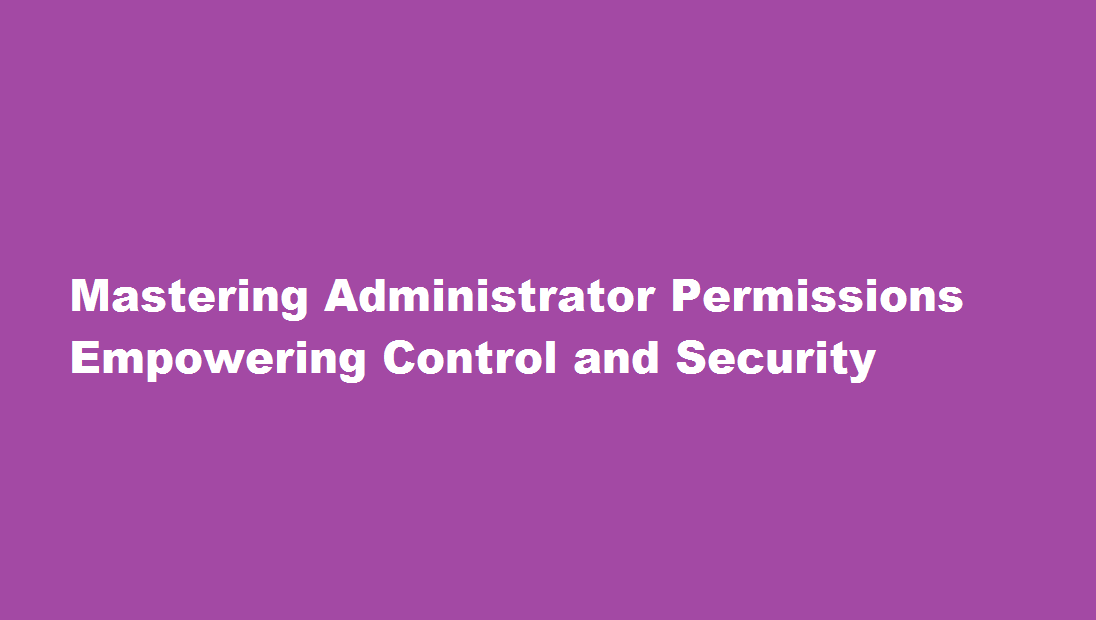Mastering Administrator Permissions Empowering Control and Security


Introduction
In today’s digital age, the significance of administrator permissions cannot be overstated. Administrator accounts grant elevated access to system settings, sensitive data, and critical functions. As such, mastering the art of providing administrator permissions is paramount for safeguarding data integrity and ensuring system stability. This article aims to delve into the intricacies of granting administrator privileges, discussing best practices, potential pitfalls, and measures to bolster security. By understanding the nuances of providing administrator permission, users can navigate this crucial aspect of system management confidently and responsibly.
Understanding Administrator Permissions
Administrator permissions represent the highest level of access control in an operating system or software environment. Essentially, users with administrator rights possess the authority to create, modify, and delete user accounts, install software, change system settings, and manage files and directories. While granting these permissions empowers users to carry out essential tasks efficiently, it also opens the door to potential security threats. Therefore, it is vital to limit administrator access to only those who genuinely require it, reducing the risk of unauthorized changes and potential data breaches.
Best Practices for Granting Administrator Permissions
- Principle of Least Privilege Adhering to the principle of least privilege ensures that users are granted only the minimum privileges necessary to perform their specific roles. This approach minimizes potential damage from accidental or malicious actions.
- Separate Administrator Accounts Avoid using administrator privileges in daily activities. Instead, create separate administrator accounts reserved solely for specific administrative tasks. Regular users should operate with standard user accounts to reduce the attack surface.
- Strong Password Policies Administrator accounts should be protected by robust passwords that combine complexity, length, and uniqueness. Regularly updating these passwords enhances security significantly.
- Multi-Factor Authentication (MFA) Implementing MFA adds an extra layer of protection, requiring an additional verification step beyond the traditional password entry. This reduces the risk of unauthorized access even if the password gets compromised.
- Regular Auditing and Monitoring Conduct routine audits of administrator permissions to identify potential security loopholes. Monitoring user activity can help detect suspicious actions and respond promptly to security breaches.
Common Mistakes to Avoid
- Over-privileged Accounts Assigning administrator rights indiscriminately can lead to unauthorized access, accidental system changes, and heightened vulnerability to cyber-attacks.
- Ignoring Updates and Patches Neglecting to update operating systems and software exposes systems to known vulnerabilities that could be exploited by attackers.
- Negligent Password Management Using weak passwords or reusing passwords across multiple accounts jeopardizes system security, making it easier for malicious actors to gain unauthorized access.
Frequently Asked Questions
Why do some files need administrator permission?
Some actions require users to provide administrator permission to copy / delete /rename files or change settings. Such permission prevents unauthorized users such as guest users, and external sources like scripts from accessing system data.
How do I open a file that requires administrator permission?
Instead, hold “Ctrl-Shift” while clicking a program from the Start menu and click “Yes” to the security warning. Doing so launches the program with elevated privileges, and any files you open in that program session have the same administrator rights.
Conclusion
Providing administrator permissions is a critical responsibility that demands both caution and foresight. By adopting best practices, avoiding common mistakes, and prioritizing security, system administrators can master the art of granting administrator privileges, ensuring a safe and efficient digital environment for all users.
In conclusion, mastering the art of granting administrator permissions is an essential aspect of system management. By understanding the significance of these privileges, adhering to best practices, and avoiding common pitfalls, administrators can effectively balance the need for efficiency and security in the digital realm.
Read Also : Nourishing Locks How to Provide Protein to Your Hair for Optimal Health
Recent Posts
A Step-by-Step Guide to Turning Off Your PS4
Introduction The PlayStation 4 (PS4) has been a gaming staple for millions of gamers worldwide…
How to Get a Receipt from Amazon – A Step-By-Step Guide
Amazon, the world's largest online retailer, offers a convenient and efficient way to shop for…
How to Leave a Group Chat on iPhone – A Step-by-Step Guide
Introduction Group chats are a fantastic way to stay connected with friends, family, or colleagues,…
A Comprehensive Guide on How to Pack a Bowl
Introduction Packing a bowl is a skill that many individuals enjoy mastering, whether for medicinal…
How to Properly Turn Off a Tesla Electric Vehicle
Introduction Tesla electric vehicles (EVs) have revolutionised the automotive industry with their cutting-edge technology and…
The Art of Capturing Majesty – A Step-by-Step Guide on How to Draw an Elephant
Introduction Drawing is a beautiful form of expression that allows us to capture the essence…


